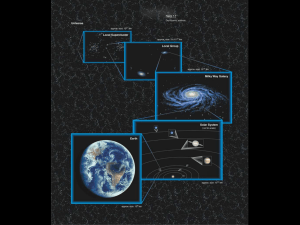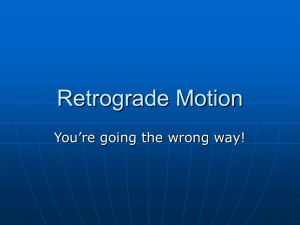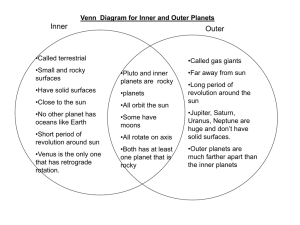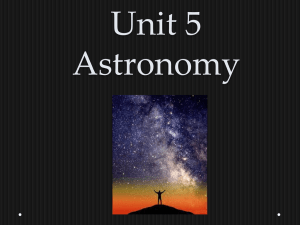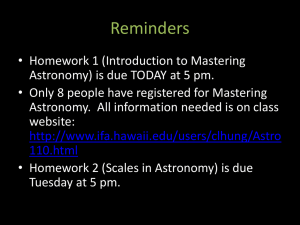Lecture4
advertisement
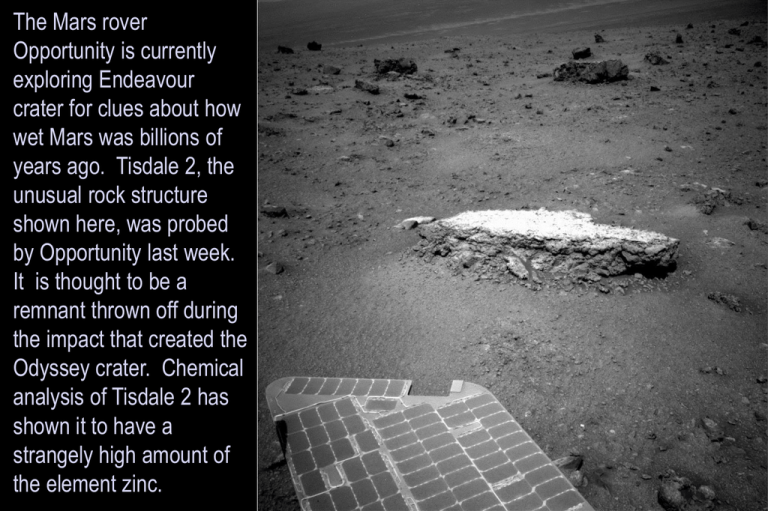
The Mars rover Opportunity is currently exploring Endeavour crater for clues about how wet Mars was billions of years ago. Tisdale 2, the unusual rock structure shown here, was probed by Opportunity last week. It is thought to be a remnant thrown off during the impact that created the Odyssey crater. Chemical analysis of Tisdale 2 has shown it to have a strangely high amount of the element zinc. Homework #1 has been posted on the class website. Answers are to be submitted via the OnCourse “Original Test and Survey” program. Work through the homework questions and arrive at all your answers before going to OnCourse. Then, go to the A103 class page on Oncourse, click on the “Original Test and Survey” button, and chose Homework 1 from the pull-down menu. Input your answers. Once this is accomplished, be sure to submit the homework. You cannot exit the program and return to it later! DO NOT SUBMIT UNTIL YOU HAVE GIVEN ALL YOUR ANSWERS – YOU CANNOT GO BACK ONCE YOUR ANSWERS ARE SUBMITTED. Understanding the context of our search Celestial Sphere Large imaginary spherical surface centered on the Earth. Stars and other celestial objects “fixed” on its surface. Conceptual Model, not a physical model Patterns Observed in the sky: (observed facts) Stars rise in the eastern sky and set in the western sky The Sun rises in the eastern sky and sets in the western sky The rising and setting locations for the Sun on the horizon change in a recurring pattern Relative to background stars, the Sun moves slowly, approximately one degree per day, towards the east The sun follows the same path around the sky (on the celestial sphere), repeating this journey once every year. This path is called the “Ecliptic” Planets are always found close to the “ecliptic”, the apparent annual path of the sun through the sky. Mercury and Venus, often referred to as the inferior planets, are always close to Sun in sky, with Mercury staying the closest to the Sun Motions of the planets On short term (minutes, hours), planets appear to move with the stars, east to west, making a full circuit around the sky (meridian to meridian) in approximately one day On the longer timescale (days, weeks, months), planets move slowly eastward relative to the stars: different planets moving at different rates Some planets occasionally reverse their motion relative to the stars, moving slowly westward relative to the stars, for a few days apparent retrograde motion The observed motions of the stars, sun, moon, and planets in the sky provide us with “observed facts” What accounts for these observed facts? (construct a model and then test it) The Greeks developed a model for the Universe that lasted for nearly 15 centuries. It did a reasonably good job explaining these motions. Ptolemy and later scientists were strongly influenced by the belief of Plato that … “all natural motion is circular” ● Earth is at center (Geocentric) ● Sun orbits Earth ●Planets orbit on small circles (epicycles) whose centers orbit the Earth on larger circles (this explains retrograde motion) Ptolemy’s Geocentric Model Apparent retrograde motion in geocentric model Planet orbits lie in approximately the same plane (this explains why the planets are always near the ecliptic) Inferior planet epicycles were fixed to the Earth-Sun line (this explained why Mercury & Venus never stray far from the Sun). Geocentric Model Ptolemy’s Geocentric Model ● Relied upon circles upon circles (epicycles & defferents) to explain the motions of planets and the sun. ● Tied to Plato & Aristotle’s belief that “all natural motion is circular” ● With modifications (e.g., additions of epicycles upon epicycles), remained the standard through the middle-ages. Ptolemy’s model fit the data and made accurate predictions, but was horribly contrived! Plato proposed that the orbits of the planets have what shape? conical circular elliptical equal-angular epicycles Plato proposed that the orbits of the planets have what shape? conical circular elliptical equal-angular epicycles The diurnal (daily) motion of stars is due to the motion of the earth around the sun the rotation of the earth the epicyclic nature of the celestial sphere the rotation of the celestial sphere The diurnal (daily) motion of stars is due to the motion of the earth around the sun the rotation of the earth the epicyclic nature of the celestial sphere the rotation of the celestial sphere What is the ecliptic? when the Moon passes in front of the Sun the constellations commonly used in astrology to predict the future the Sun's daily path across the sky the Sun's apparent path across the celestial sphere What is the ecliptic? when the Moon passes in front of the Sun the constellations commonly used in astrology to predict the future the Sun's daily path across the sky the Sun's apparent path across the celestial sphere About how long does it take the Sun to complete one “trip” around along the ecliptic around the entire sky? One day One month One year The time varies from one trip to the next This never happens About how long does it take the Sun to complete one “trip” around along the ecliptic around the entire sky? One day One month One year The time varies from one trip to the next This never happens The Revolution Begins! Nicolaus Copernicus (1473-1543) He thought Polemy’s model was contrived Yet he believed in circular motion De Revolutionibus Orbium Coelestium Copernicus’ Heliocentric Model ●Sun is at center of the Universe ●Earth orbits the Sun like any other planet ●Earth rotates ●Circular orbits for all planets ●Inferior planet orbits are smaller ●Planets move at constant velocities in their orbits ●Retrograde motion occurs when we “lap” Mars & the other superior planets Copernicus’ Heliocentric Model ●Retrograde motion occurs when we “lap” Mars & the other superior planets Simpler, more “elegant” But, it still required some epicycles in order to make accurate predictions because It was still wedded to Aristotle's circular orbit paradigm Predictions were not much better than those of Ptolemy Tycho Brahe (1546-1601) ● Greatest observer of his day • Charted accurate positions of planets (accurate positions of the planets were not fully available) Tycho Brahe… was motivated by inadequacy of existing predictions made very accurate observations of positions (this was prior to the development of the telescope) advocated a model in which Sun orbits Earth because he could not observe stellar parallax The parallax problem troubled the Greeks and Tycho. It led both to reject a heliocentric universe. The problem was that stars are too distant to produce a parallax large enough to be seen with the technology of those time. 1600 – Tycho brought Johannes Kepler to bear on problem. He assigned him the task of understanding the motions of Mars. Kepler had great faith in Tycho's measurements; they placed strong constraints on model Johannes Kepler (1571-1630) ● Hired by Tycho to analyze his observations of planetary positions, particularly Mars ● Greatest theorist of his day ● Believed that “forces” made the planets move ● Developed his three laws of planetary motion Kepler's Laws 1. The Law of Orbits: All planets move in elliptical orbits, with the sun at one focus. 2. The Law of Areas: Planets move faster in their orbit the closer they are to the Sun. 3. The Law of Periods: Planets on larger orbits take longer to complete an orbit than planets smaller orbits. Kepler’s First Law Each planet’s orbit around the Sun is an ellipse, with the Sun at one focus. Ellipse: defined by points located such that the sum of the distances from the two foci is constant Animation by Michael Kossin x2/a2 + y2/b2 =1 focus y The circle is a special form of an ellipse Semimajor axis = a X Semiminor axis = b Eccentricity e2 = 1 - b2/a2 Kepler’s Second Law ● A planet moves along its orbit with a speed that changes in such a way that a line from the planet to the Sun sweeps out equal areas in equal intervals of time. ● Consequence: planets move faster when they are closer to the sun and, conversely, planets spend more time in the more distant parts of their orbits A good animation demonstrating this law can be found at: www.physics.sjsu.edu/tomley/Kepler12.html Kepler’s Third Law The ratio of the cube of a planet’s average distance from the Sun “a” to the square of its orbital period “P” is the same for each planet. 3 2 a / P = constant The constant is the same for all planets Consequence: Planets with larger orbits have longer orbital periods. A good animation demonstrating this law can be found at: www.physics.sjsu.edu/tomley/Kepler3.html 3 2 a / P = constant Earth: a = 1 AU, P = 1 year So, if we measure the size of a planet’s orbit in AU and its orbital period in Earth years, then constant in the 3rd Law is 1 AU3 yr-2 Jupiter: a = 5.203 AU, P = 11.86 years

